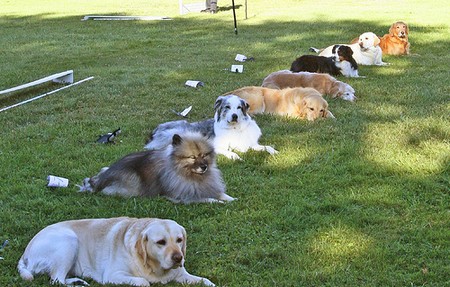One of the main reasons for teaching your pup the “stay” command is to make handling it easier—when it is still young, and also when it is a grown dog. Once your dog knows how to “stay”, you will no longer have to wrestle with it every time you want to put a lead or collar on it.
If guests arrive at your home, you will be able to make your dog stay in a “sit” or “down” position while they-enter. With our own dogs, we try to reinforce this behavior by constant repetition. We use the “stay” command whenever we bring them into or out of our house. The rules are that, as soon as we open any door, the dogs must sit first, and wait until they are invited to come in or go out.
Doing this will help you avoid the common situation of having your dog bolting either into or out of the house as soon as a door is opened. This behavior may become a real problem, as we all find ourselves opening our doors many times a day.
To teach the “stay”, put your dog on lead and place it in the “sit”. Then place your hand in front of its face, level with its nose, and say, “Stay.” Next, take one big step, turning your whole body to face the dog as you do, and also keeping your eye on it as you move.
This way you will be able to see when to use the one-word reprimand, “Bah” or “Bad,” if your dog tries to follow you. Remember, it is important that you reprimand at the precise moment your dog moves, not a little later. A late reprimand will only lead the dog to misread the reason it was reprimanded.
If, for example, your dog moves off the spot and walks over to you and you reprimand as it reaches you, then it will think it is acceptable to move from the sit—it is just not acceptable to approach you.
So you will need to keep your concentration on your dog as you step away from it, in order to get the correct message through to it.
Be sure to stand up straight and stay put unless your dog moves. If it does, growl your reprimand word. Without rushing or grabbing at the dog, calmly take it back to the spot it moved from. Repeat this exercise over and over until it stays on the spot waiting for you to return to its side.
You can gradually increase your distance from the dog so that you are out of its sight—but ensure that you can see it, so that you can check to ensure that it doesn’t move from the “stay”.
When your dog has “stayed” for a minute, return to its side, wait a few seconds, and then say “Free.” Praise it, and pat it lavishly. It has done what you wanted, and you must reward it.
Daily training is important if you want your dog to respond to-your commands, and to adopt the “sit” and “stay” positions whenever you wish it to.
If you start by using only the one-word reprimand, rather than the command you require your dog to follow, it will do the exercise immediately: if it tries to move from the “sit” or the “stay”, and you utter the “Bah” or “Bad” word, it will respond to this. Later it will start realizing that the “sit” position corresponds to the command “Sit,” and at this stage you can teach it the command word; by this time it will already be doing the exercise correctly anyway, because of its conditioned response to the reprimand word.
Timing
As we have shown above in relation to the “sit” and the “stay” exercises, timing is vital in all obedience exercises if you want to teach your dog both quickly and easily. You must only reprimand at the precise instant the dog moves or does the wrong thing, not after the fact. In order for it to interpret correctly what you want, your dog must be able to associate what it is doing wrong with the reprimand it knows.
Likewise, it must receive praise the instant it does the right thing. Let it know at the correct moment, “This is what I want from you.” lf your dog looks or acts confused, it is only because your timing is wrong and it is getting the wrong message.
